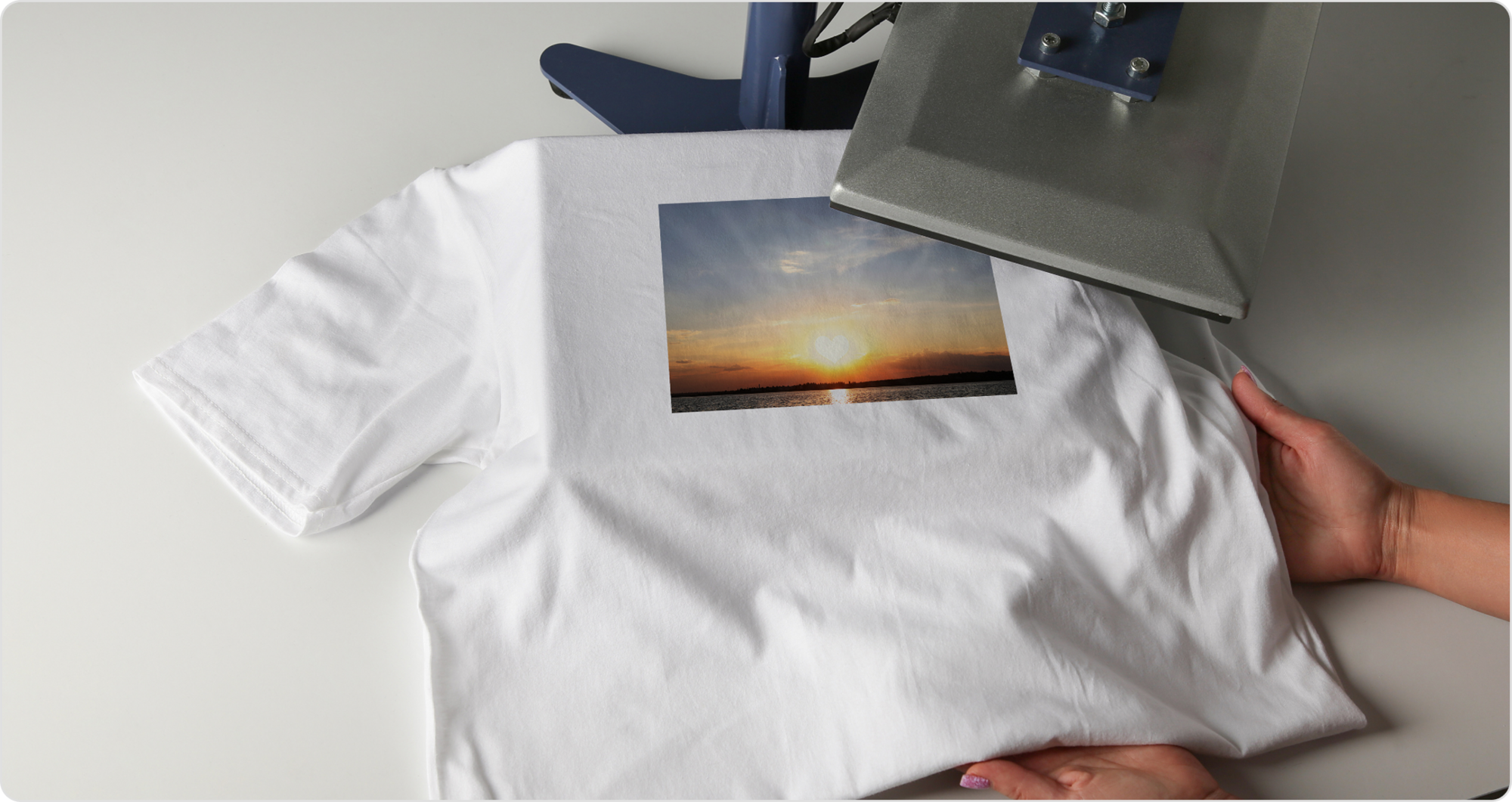Heat transfer printing

If you’re looking to create custom merchandise with heat transfer printing, this is the guide for you.
We explore several frequently asked questions about how heat transfer works, how it compares to other popular print methods, and more.
What is heat transfer?
In the printing world, heat transfer refers to the process of copying a design or image onto a substrate (material), typically fabric, by using heat and pressure. A special sheet with the desired design is placed on the fabric, and then a heat press is used to transfer the image onto the material.
How does the heat transfer process work?
First, it’s important to understand the key elements involved in the heat transfer process:
- Heat. The temperature of the heat press is crucial for activating the adhesive and ensuring a strong bond between the transfer sheet and the fabric. The optimal temperature can vary depending on the type of transfer sheet and the fabric being used.
- Pressure. The pressure applied by the heat press is equally important. It helps to ensure that the transfer sheet adheres evenly to the fabric and prevents air pockets from forming.
- Transfer sheet. The quality of the transfer sheet can significantly impact the outcome of the heat transfer process. High-quality transfer sheets are made from durable materials and have a strong adhesive that can withstand repeated washes and wear.
- Substrate. The material onto which the design is transferred is also a factor. Different fabrics have varying properties, and some may require specific heat and pressure settings to achieve optimal results.
Now here’s how the heat transfer printing process works:
- Design creation. You create your desired design digitally or physically. This may involve using design software, sketching by hand, or even scanning existing artwork. In general, high-quality, high-resolution images or vectors will produce the best results.
- Transfer sheet preparation. After we receive your design, we transfer the design onto a special sheet coated with a heat-sensitive adhesive. This sheet is often made of a polyester or paper fabric. The adhesive is formulated to bond with the fabric under specific heat and pressure conditions.
- Application. We then place the transfer sheet on the fabric and use a heat press. The heat press applies both heat and pressure to the transfer sheet and fabric. The heat activates the adhesive on the transfer sheet, causing it to bond with the fibers of the fabric. The pressure ensures that the design adheres securely and prevents the transfer sheet from shifting or wrinkling.
- Peeling. Once the transfer is complete, we peel off the paper backing of the transfer sheet. This leaves the design permanently adhered to the fabric.
The result is a permanent, high-quality, visually appealing image applied to your chosen fabric that is resistant to fading, peeling, and other forms of wear and tear.
What’s the difference in heat transfer vs. screen printing vs. sublimation?
If you’ve heard about heat transfer printing, you’ve likely heard about screen printing and sublimation printing as well.
So, what’s the difference between these three methods? In the table below, we provide a quick rundown of the similarities and distinctions, as well as advantages and disadvantages of the three methods.
Based on the above table, which printing process should you use? Here’s a general summary:
- Heat transfer printing is ideal if you’re looking for a versatile, cost-effective customization method for a product that will not be frequently washed or exposed to heat.
- Screen printing is best suited for large-scale productions that prioritize the durability of the print.
- Sublimation printing excels in producing high-quality, all-over prints on polyester fabrics.
Of course, the best method for a particular project will depend on factors such as the desired quality, quantity, budget, and type of fabric.
What kind of designs are most suitable for heat transfer?
Since one of the main advantages of heat transfer printing is its versatility, there are numerous kinds of heat transfer designs you can use, such as:
- Geometric patterns like stripes, checkerboards, triangles, and hexagons.
- Typography such as motivational quotes, popular sayings, names, dates, and unique fonts.
- Nature-inspired designs like flower patterns, simple animal silhouettes, and leaves.
- Abstract art such as splatter patterns, swirls, and gradients.
Compared to other customization methods, heat transfer is perfect for complex, multi-colored designs, as there are no color limitations. You can even print photos or other photorealistic designs. However, printing over large areas of your product may result in stiffness.
What type of products are suitable for heat transfer?
While heat transfer printing can be used for a wide variety of products, you should avoid using it on products that will be frequently worn and washed, as the print will fade over several washes. For example, we recommend:
- Apparel that isn’t washed frequently, such as hats or caps
- Home décor such as pillowcases, curtains, tablecloths, and other home furnishings.
- Industrial items such as equipment labels, tags, and other identifying markings.
- Promotional items like mugs, tote bags, water bottles, and other branding products.
Key takeaways for heat transfer printing
Heat transfer printing is a versatile printing process that can help you bring unique designs to life on everything from jackets to equipment labels. Though depending on your specific needs, sublimation or screen printing may be a better choice.
Looking to create a custom product with heat transfer printing? Explore our catalog of unique products – all offered at factory-direct prices. Minimum orders start at 20 units and can be shipped in as little as two weeks. If you're looking for something fully custom, submit a custom request with our AI agent Nory.